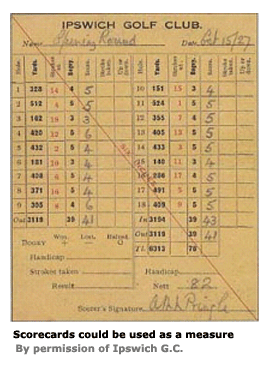|
Henry Cotton had a
disappointing 79 dropping him to 7th place. His preparation for 1934
would now begin in earnest.
I never had the yen to return to St Andrews that I felt for other
places with happier memories. Attitudes did not change until after
my time and, unlike Bobby Jones and Henry Cotton, whose initial
dislike turned to love, my first impression of the ‘home of golf’
never really left me. Maybe it would have grown on me as well in
time if I had played there more often. Eventually Hagen and Cotton
were made honorary members of the R&A and their influence was a
major factor in raising the status of the professional golfer, but
that was still a long way ahead. In that Open one of our
instructions told us not to sign for spectators when leaving the
18th’, where a sign said: ‘Please do not pester the players for
autographs’. How times have changed! The dignity of the proceedings
was disturbed by the antics of another famous Trick Shot artist of
those days, the American Joe Ezar, who chased his eight yard putt
across the last green and dived to drop his hat over the cup as the
ball dropped in. The R&A would not have been impressed. More of
Joe’s outrageous exploits come later.
 Syd Easterbrook is not well remembered these days, but at that time
he was at the top Syd Easterbrook is not well remembered these days, but at that time
he was at the top
of the game, frequently in the big money and feared in match play.
That year I had met him in the Y. E. N. (the Yorkshire Evening News
Matchplay tournament) at Temple Newsam near Leeds, (where Percy
Alliss was pro in the mid thirties) and it was there that I played
what was probably my most memorable shot, in what I regard as being
my toughest match. It was a fluctuating game and the balance was in
favour of Easterbrook on the 17th tee. At this hole I went over the
green with my second shot; he was short and played his approach
first laying it about two feet from the hole. I then had to play a
blind pitch from down the bank, which finished about four feet away.
Syd’s ball was on my line, but in those days the ‘stymie’ rule
applied in match play and you could not have your opponent’s ball
marked if there was more than 6 inches between them. (The scorecard
was sized 6" so that it could be used as a measure). On the bone
hard green I was confronted with a dead stymie and was one down so
it looked like ‘curtains’. I had to hole to get a half and keep the
match alive so I decided to play a bounce shot with a mashie-niblick
(7 iron). I pitched in front of his ball and bounced over it into
the cup. At the 18th I hooked my drive and was on the wrong side of
the fairway, leaving a very difficult approach over the side bunkers
to a double-decker green. With nothing to lose I went straight at it
with a full spade-mashie (6-iron) and was delighted to see it carry
the bunkers and finish about five yards beyond the flag. I holed the
putt to square the match and was round in 69 to Syd’s 70. Off we
‘scrambled’ down the 19th and halved the hole in one-over fives. On
we went to the 20th, a hole of almost 300 yards in those days. I
drove the green and Syd’s drive also made it but fell off into the
right hand bunker. He failed to get up and down and my birdie three
secured the win.
The stymie rule seems incongruous now and it certainly caused a lot
of ill feeling between golfers back then; the deliberate ‘laying of
a stymie’ won and lost many a match and some big events and it was
very irritating when you stymied yourself. Most players were in
favour of its abolition, but the powers that be steadfastly
supported it and it surprises many people when they learn that it
was not finally abolished until 1951.
In the quarterfinals of the Y. E. N., I beat Syd’s Ryder Cup teammate,
Alf Perry, at the 19th, before losing to another Ryder Cup player,
Alf Padgham, in the semi-finals.
Alf lost to his friend Arthur Lacey in the final - the two had
practised together and had taken turns to drive Arthur’s car up from
London. Arthur was a very long but erratic player. He once reached
the semi-final of the News of the World, but won little at home. His
biggest wins were on the Continent, where he had preceded me as
French Open Champion and was twice a winner of the Belgian Open.
[On completion of the six qualifying events that year, Bert was to
finish third in the averages in only his second season on tour. His
average of 74.66 was just behind Easterbrook’s 74.62. Padgham was
top with 73.91]
I qualified for the Penfold Porthcawl tournament with the 6th best
qualifying rounds of 75 and 74. In the championship proper a
hitherto little acclaimed player had a round to remember - John
Burton of Hillside, Southport, brother of Dick, the next St Andrews
Open Champion, shot a 67. It was the only sub 70, score - rounds
under 70 were not that common in those days and the Royal
NEXT |